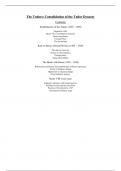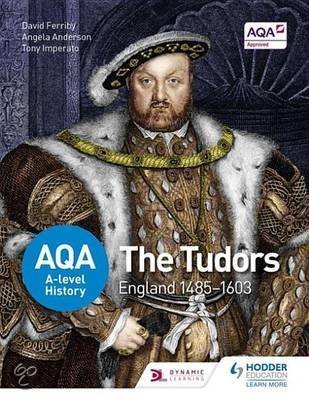The Tudors: Consolidation of the Tudor Dynasty
Contents
Establishment of the Tudors (1485 - 1509)
England in 1485
Henry VII’s consolidation of power
Removing threats
Foreign Policy
The last decade
Rule of Henry VIII and Wolsey (1509 – 1529)
The start of a new era
Wolsey as chief minister
Foreign policy
Kings Great Matter
The Break with Rome (1530 – 1540)
Reformation parliament and establishment of Royal supremacy
Extent of religious change
Opposition to religious change
Royal authority and gov
Henry VIII’s last years
England’s relations with foreign powers
Factions at court and the succession
Position of the church by 1547
Assessment of Henrys reign
,Establishment of the Tudors (1485 – 1509)
England in 1485
English society by 1485:
Basic stats
- Population of 3 million – 90% lived in rural communities
- Towns were small and urban settlements were cramped
Farming
Arable farming labor intensive farming producing crops using basic tools like ploughs
Arable farming as used in Southern England and the Midlands. Aside from this, places had
their own identity. In large open fields in areas of arable farming – the land was divided into
strips and given by the local landowner to tenants. Most villages also had common land –
where all villagers could graze their animals.
Even in the late 15th century there were some concerns around enclosure (fencing off of land
from open fields with the ending of all common rights). Tenant farmers could lose their strips
of land when landowners wanted to change farming methods.
Common land being enclosed provoked fierce opposition – villagers claimed customary
rights of access to common land. Fencing off these areas deprived of land for their animals,
cutting timber or for fishing and hunting.
Anti-enclosure law passed in 1489 – attempt to deal w perceived problem (had little practical
applications).
In the Midlands less than 3% of land was enclosed, more had been enclosed during the Wars
of the Roses but it was seen to be more important in Henry’s reign due to the confusion of
this and engrossing (joining several farms together to make one unit).
Cloth industry:
This accounted for nearly 80% of England’s exports. It was exported to the Netherlands,
Spain, the Holy Roman Empire and Venice.
Most of this trade was controlled by Merchant Adventurers – exported the cloth and imported
foreign goods in return.
English quality of wool was excellent, therefore was in great demand.
Customs duties money paid on goods entering / leaving the country – success in wool
trade increased amount of money.
Society
The Great Chain of Being was generally accepted – thought that God had ordained this.
Social status dominated society – the Church was therefore in a powerful position to control
the people by preaching obedience to the will of God, making the Church an indispensable
ally of the govt.
,There were approx. 50 nobles who owned large areas of land. There were strict laws of
primogeniture inheritance within these families. The relied on noble support to maintain law
and order in their areas of the country. Some monarchs in the 15th century had tried to buy
support by granting new titles – Henry VII did the opposite and created only 3 earls in his
reign. Important nobles maintained extensive households e.g. the Duke of Northumberland in
1503-4 had 187 household members.
Below the nobles were the gentry, merchants, commoners, and beggars.
The pinnacle of the social hierarchy was the monarch, who ruled through god (DROK not
official). The monarch still needed the support of leading nobles to provide law and order and
an army in times of war. His advisors were meant to be mainly drawn from the nobility.
In England, there was common law and an accepted language (aside from in places like
Cornwall). Wales was regarded as a part of England. In theory the king controlled the whole
country but in practice some places had some independence, being lead by nobles or the
church from Durham / York.
The Catholic Church:
The Catholic church was immensely powerful in the late 1400s:
- It owned 1/3 of all English cultivated land
- Had its own legal system and clergy were tried in church courts
- Extreme psychological power
o Disease was common and medicine poor
o Church depicted a clear view of heaven / hell – helpful for illiterate
o Fear of hell and wish for heaven led people to the churches
- Controlled all education
The church also had a hierarchy from Archbishops down to poor parish priests (earned less
than £15 pa). Approx. 35,000 ordained clergy and 10,000 monks and nuns.
Teachings from the catholic church pope was head of the Church and had supreme
authority. Papacy was recognized as a Court of Law
The Papal Curia under the pope acted as a Court of Appeal.
The Clergy held special place within the
community. Only formally appointed
priests could conduct services in church
and access to the bible was limited to
who could read Latin.
Priests were visibly separted from the rest
of the country – they wore vestments – and
were not allowed to marry or have sex.
Cardinals senior churchmen, elected pope
Archbishop senior churchmen in country
Bishop regional leaders
Parish priest minister to each ongregation
OMO = Augustinians, Franciscans, Dominicans
, Seven sacred sacraments which the church performed:
1. Eucharist (commemoration of the Last Supper)
2. Baptism
3. Holy orders (granting someone status as priest)
4. Confirmation (recipient confirming acceptance of god in their hearts)
5. Marriage
6. Confession, leading to penance
7. Unction (anointing of the sick)
To save one’s soul, an individual should attend church, believe in the sacraments and show
their faith in God.
The church was a part of the social fabric of the community. Great pride was taken by the
community in building and maintaining their local village church – e.g. in Lincolnshire £305
to build the parish church in 1501 (later raised money for a spire).
2/3 of all English parish churches were rebuilt during the 15th century. There were gifts of
vestments, plate and jewels.
Other support of the catholic church pre-1529:
- Church building
o People paid for the building / extension / restoration of churches
o Period before 1530 no let up in building rates
- Catholic literature
o Printing presses in England produced more conservative literature than
protestant anticlerical
o Catholic novels in 1501 – 1520, 37 editions
o Catholic novels in 1521 – 1530, 41 editions
- Evidence of wills
o 2,500 wills from 1500 – 1530 show essentially all dedicated their possessions
to a religious cause
o Many families invested heavily in the traditional catholic church
Often historians overexaggerate the corruption in the church.
The church helped villages to find a sense of identity and collective purpose. They would
gather to celebrate Holy Days. The church altered an individual’s perception of time and
reality and so bound villages together. St Georges Day and May Day are two examples of
religious festivals.
Faults in the secular church:
- Higher and lower clergy were too distinct
o Higher were drawn from richer yeomen, small gentry, merchants etc
o They were given university education and could attempt to become an
archbishop (£3,000 a year) or one of the 17 bishops (£1,000 - £2,500).
o 50% of the 9,000 parish priests earned less than £10 a year





